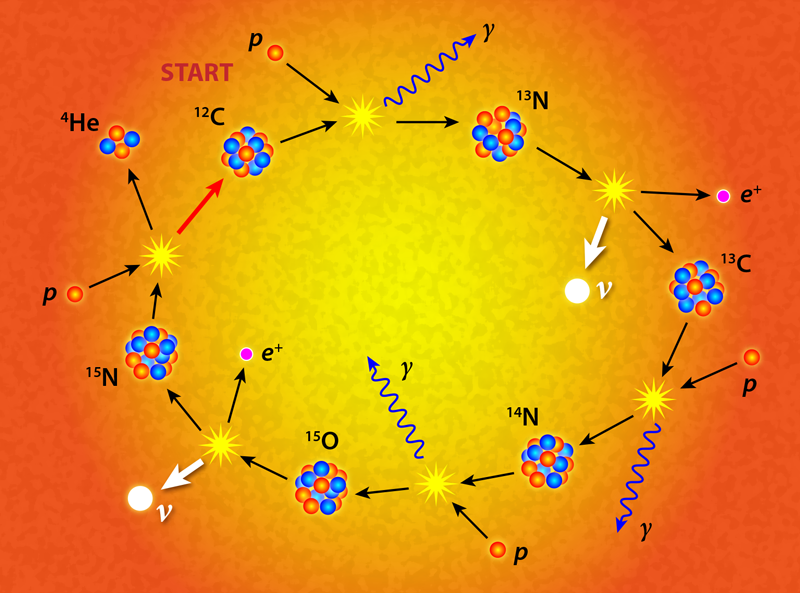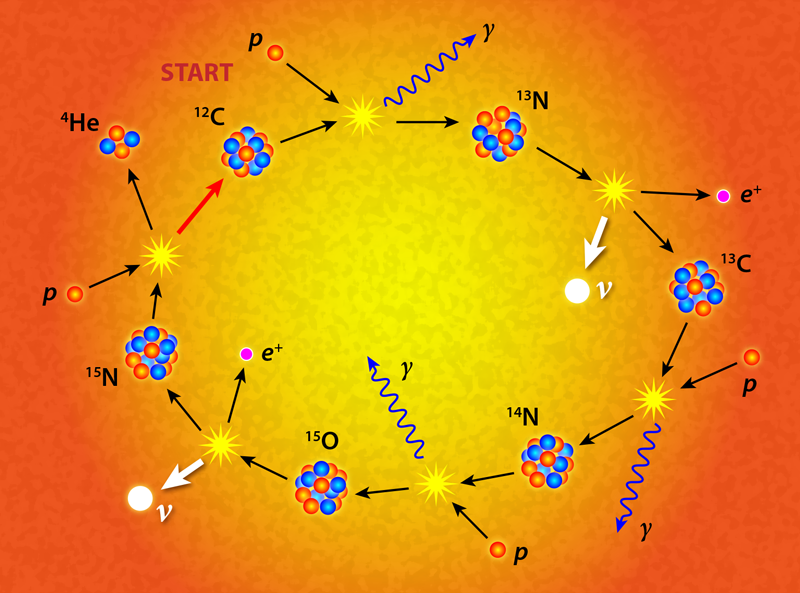Elemental Accounting of the Solar Interior
Solar neutrinos are copiously produced by hydrogen fusion reactions in the Sun’s core. Therefore, they are the direct evidence that the Sun is powered by nuclear reactions. Measurements of solar neutrinos have provided information about the temperature and density of the solar interior, but uncertainties remain about the chemical ingredients. Now the Borexino Collaboration reports a new measurement of the neutrino flux produced by the so-called CNO hydrogen burning cycle in the Sun [1]. This cycle—which requires the presence of carbon (C), nitrogen (N), and oxygen (O)—produces neutrinos that carry enormous diagnostic power relating to the properties of the solar interior. By measuring these neutrinos, the collaboration provides a precious piece of information about the elemental makeup of the Sun, bringing us closer to resolving a controversy that has plagued solar physics for over 20 years [2].
Stars spend about 90% of their lifetimes fusing hydrogen into helium, producing two neutrinos in the process. The pp chain—or proton–proton chain—and CNO cycle are the two fundamental modes by which stellar fusion occurs. Whether a star is dominated by the pp chain or the CNO cycle depends on its core temperature, which is primarily determined by the mass of the star. In the Sun and similar low-mass stars, the pp chain generates almost all the nuclear energy; the CNO cycle is the main power source for more massive stars. The pp chain is a series of nuclear reactions that require no additional nuclei besides hydrogen as fuel. By contrast, the CNO cycle relies on the presence of C, N, and O nuclei as catalysts in the production of helium (Fig. 1). In the Sun, this catalytic process introduces a linear dependence between the amount of C, N, and O and the flux of CNO neutrinos. Thus, CNO neutrinos are a powerful tool for probing the chemical composition in the Sun’s core.
Knowing the Sun’s chemical composition is important not just for solar physics but for all of astronomy, as the solar abundances for different elements provide a “chemical ruler” for measuring the elemental abundances in other stars and gas clouds [3]. There has, however, been a long-standing controversy surrounding the solar abundances. The main technique for measuring the Sun’s chemical composition is observing absorption lines in the solar spectrum. Early spectroscopic studies found relatively high levels of key elements such as C, N, and O, but in the early 2000s advanced techniques began to measure abundances that were 30 to 40% lower than the preliminary estimates. When these lower abundance values are used as inputs for the standard solar model (SSM)—the physical framework for calculating the Sun’s structure and evolution—the predictions strongly disagree with helioseismology measurements of the Sun’s interior structure [4]. On the other hand, the older solar abundances—which are based on simplistic and outdated modeling—lead to SSM predictions that are remarkably in-line with helioseismology data [5].
This 20-year-old paradox, dubbed the solar abundance problem, has defied a satisfactory solution. The most recent spectroscopic measurements seem to be moving toward better agreement with the helioseismology observations [6]. Nevertheless, the solar physics community has long been on the lookout for an independent way to measure the chemical abundance of the Sun. And it is here where neutrinos and the new Borexino results come into play.
Located deep underground in Italy’s Gran Sasso National Laboratory, the Borexino Collaboration measures the energy spectrum of the solar neutrino flux down to very low energies (around 100 keV) and separates the individual contributions originating from different nuclear reactions in the Sun’s core. From its analysis of data from the experiment’s final phase III (January 2017 to October 2021), the collaboration estimated 4.8 counts per day of CNO neutrinos in the detector’s volume of 71.3 tons. The collaboration previously reported a detection of CNO neutrinos in 2020 [7] but have now reduced the measurement errors by a factor of 2, allowing the team to make inferences about solar abundances.
The CNO flux measurement can be turned into a measurement of C plus N abundances by including measurements of another neutrino flux: that from boron-8 decay, which strongly depends on temperature [8]. The collaboration used this flux to constrain the Sun’s core temperature to a precision of about 0.1%. The team applied this temperature to the relation between the CNO flux and the C, N, and O abundances, arriving at the first-ever measurement of chemical abundances in the Sun’s core. Relying only on neutrino measurements, this methodology offers a truly independent determination of the solar composition against which spectroscopic determinations, new and old, can be checked. The results strongly favor the Sun having high C, N, and O abundances, contrary to the estimates from modern, state-of-the-art spectroscopic studies (with the exception of E. Magg et al. [6]).
The discrepancy between the core abundances estimated by Borexino and the surface abundances measured by spectroscopic studies may imply that the Sun’s chemical composition varies with depth. Such a nonuniform distribution of elements could be explained, for example, by the Sun having formed in an inhomogeneous environment, or by the Sun’s outer layers having been enriched in certain elements by accretion of planetary material [9, 10].
Testing these hypotheses will require more refined CNO-neutrino measurements. Sadly, Borexino shut down in 2021, and there is currently no experiment that can observe solar neutrinos at low enough energies. Borexino has, however, left us with an impressive legacy, as its measurements of the CNO flux and other solar neutrino signals represent landmarks for future neutrino experiments. The Borexino team developed technologies, particularly in radioactive purification, that are and will be of great benefit for other experiments, such as the SNO+ neutrino experiment in Canada. The collaboration also developed data-analysis techniques for background subtraction that will certainly find future applications in neutrino studies as well as dark matter searches. There are no plans yet for a dedicated solar neutrino experiment, but if one were to be built using the expertise acquired by Borexino, it would have a bright future and would provide invaluable information about the Sun.
References
- S. Appel et al. (Borexino Collaboration), “Improved measurement of solar neutrinos from the carbon-nitrogen-oxygen cycle by Borexino and its implications for the standard solar model,” Phys. Rev. Lett. 129, 252701 (2022).
- J. N. Bahcall et al., “Helioseismological implications of recent solar abundance determinations,” Astrophys. J. 618, 1049 (2005).
- M. Asplund et al., “The Chemical composition of the Sun,” Annu. Rev. Astron. Astrophys. 47, 481 (2009).
- S. Basu and H.M. Antia, “Helioseismology and solar abundances,” Phys. Rep. 457, 217 (2008).
- N. Vinyoles et al., “A new generation of standard solar models,” Astrophys. J. 835, 202 (2017).
- E. Magg et al., “Observational constraints on the origin of the elements,” Astron. Astrophys. 661 (2022).
- The Borexino Collaboration, “Experimental evidence of neutrinos produced in the CNO fusion cycle in the Sun,” Nature 587, 577 (2020).
- W. C. Haxton and A. M. Serenelli, “CN cycle solar neutrinos and the Sun’s primordial core metallicity,” Astrophys. J. 687, 678 (2008).
- A. M. Serenelli et al., “Solar models with accretion. I. Application to the solar abundance problem,” Astrophys. J. 743, 24 (2011).
- M. Kunitomo et al., “Evidence of a signature of planet formation processes from solar neutrino fluxes,” Astron. Astrophys. 667 (2022).





